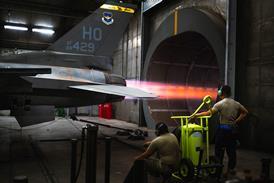PAUL LEWIS / WASHINGTON DC
US Army financing problems will delay production of the soon-to-fly CH-47F
Boeing is readying the first CH-47F Chinook Improved Cargo Helicopter (ICH) for a maiden flight on 25 June, but is facing a 12 month slip in the start of low rate initial production (LRIP) as the result of the US Army juggling its finances.
Flight testing of the upgraded helicopter will begin at Boeing's Wilmington, Pennsylvania, facility, as will initial pilot training, which is due to continue until May next year. At that time, the US Army plans to start a three month operational test of the helicopter at Fort Campbell, Kentucky. A second CH-47F development machine will fly in September this year. Initially this will be used for electromagnetic environmental testing.

The US Army initially planned to place an LRIP contract for 11 re-manufactured machines in Dec-ember, but this has slipped to late 2002 with the number cut to nine. A second LRIP contract for 19 machines will follow in 2003, and full rate is scheduled to begin in 2004/05. The army plans to rebuild 300 of its 431 CH-47D machines by 2016 at a rate of 26 helicopters a year. Meanwhile, Boeing is seeking a deal to upgrade the 36 special forces MH-47D/Esto Gs.
"Our hope and intent would be to do the last 131 helicopters, rather than the army have a mixed fleet of CH-47Ds and Fs," says Jack Dougherty, Boeing director of domestic Chinook production. The US Army fleet is a mix of CH-47As, Bs and Cs that were remanufactured in the 1980s as CH-47Ds. The only original components remaining at the end of the CH-47F rebuild will be the centre and aft fuselage.
The ICH programme involves fitting a new, lower vibration cockpit section equipped with a Rockwell Collins avionics suite with two 150 x 200mm (6 x 8in) and four 100 x 100mm displays, and two control display units with the airframe re-lifed to 5,000h. Running concurrently with ICH is the upgrade of the CH-47's Honeywell T55-714A engine, offering 25% more power at 4,000ft (1,220m) and 35íC (95íF), plus a separately funded low maintenance rotor.
Source: Flight International























